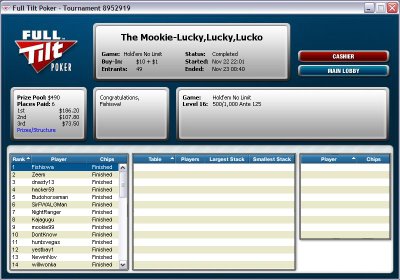More EV/Variance/Ruination Crap
Just got a very interesting comment on my post on the topic earlier this month, from someone named "David" (I play poker with several of those but they all go by their own nicknames so I wonder if I know this one).
I found it very interesting, so much so I start rambling off into a long comment. Long enough I just decided to promote it to its own post.
David said:
Your willingness to accept the consequences of statistical variance should depend on how deep your wallet is. If you are playing close to $0 EV in massive pots, then your risk of ruin is very high.
In this case, if you push, you risk $175 now to net $38 on average, giving
you about a 22% return (there's a number called the Sharp Ratio, which describes
your risk with respect to return and volatility, I have bastardized its use here to make a point). If you call, you risk $75 to net $19, giving you something like a 25% return. So it gives you a little more bankroll safety.
So, in the end, from a variance (and consequently, risk of
ruin) point of view, it is a wash, and is really up to your personal style
(which is fairly well documented).
My response:
Thanks for a very interesting comment. It made me think about things I haven't before.
I will need to read up on this Sharp ratio--I've heard of it in the most general of terms as applied to evaluating investment strategies. [after looking it up I see it's actually Sharpe and I see that as you said, you have indeed simplified it; because it's complicated beyond this discussion (and my present desire to comprehend it), I'll stick to the way I think you used it and drop the E.]
I am not fully following you however. What you have said at the beginning of the comment remains consistent with how I think about the problem in general--the willingness to take that risk has to be measured in terms of your bankroll.
Yet you go on to point to the similar adjusted returns of 22% and 25% and state that the implication is that it comes down in this case to a matter of style.
Don't you need to factor in bankroll and opportunity cost as well rather than just reward relative to amount risked? I mean as to bankroll, if this was your whole bankroll, risk of ruination would be extreme versus the push being for example 1/1000th of your bankroll where you'd really have to be pretty abysmally unlucky to go broke making this play in any iterated fashion.
As for opportunity cost, assuming risk of ruination of taking this risk relative to your bankroll is acceptably small (as it was for, though not quite 1/1000th to be sure), if I having nothing else to invest my bankroll in at that moment, isn't still a mistake not to take the higher EV?
To illustrate my attempted point, if you had $1000 and time for 100 coin flips and someone offered you the chance to win 11 cents against 10 cents per flip ("Sharp" 10%?) or 1.05 against 1.00 ("Sharp" 5%?) wouldn't you be silly to take the first bet over the second bet not withstanding the better ratio?
EV for the first choice is 1.00 with very low variance compared to $1000 and no chance of ruination, and EV of the second is $5.00 also with no chance of ruination, and a significantly higher variance relative to $1000 than the other bet (but still quite small relative to the bank roll).
More thought, the Sharpe Ratio also factors in a rate of riskless return, I wonder if that can be worked in as a missing piece to quantify what I am trying to get at with opportunity cost. Oh, this is starting to feel like I am still at work. Oh wait a minute...
Anyway, I'm glad you got me thinking about this. See the flop...









